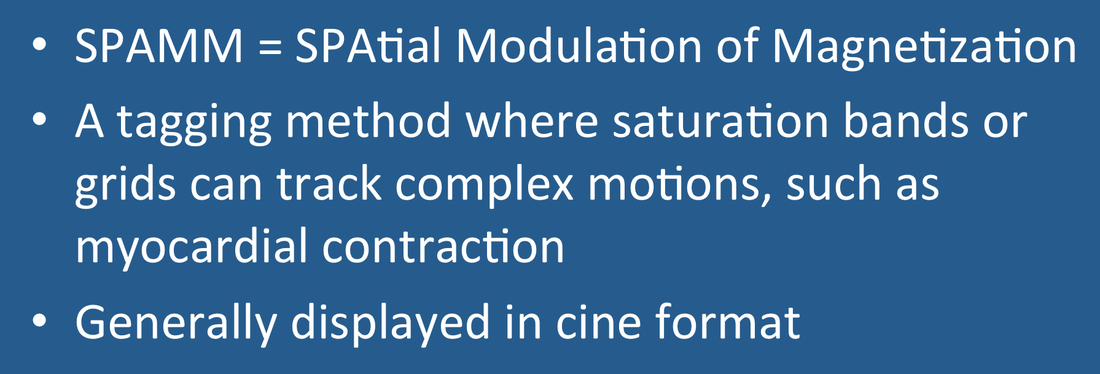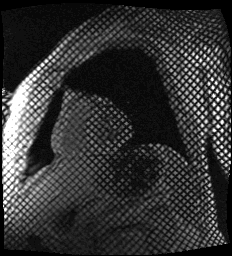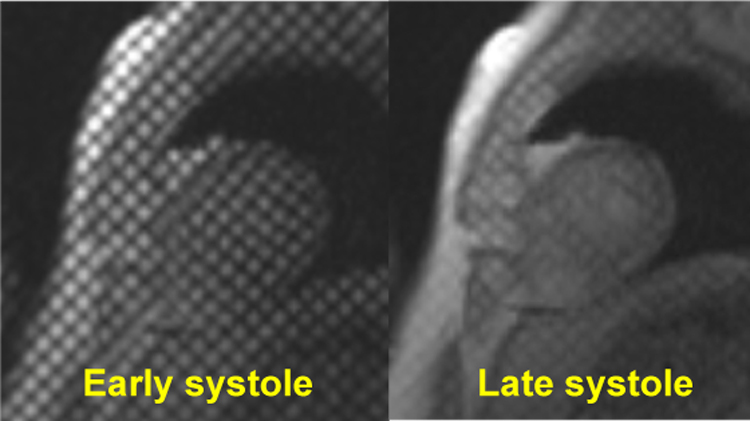|
SPAMM (SPAtial Modulation of Magnetization) is a technique where RF-saturation pulses are used to place stripes or grids on the heart to follow its motion during the cardiac cycle. The images obtained are typically displayed in a cine format, allowing for both visual and quantitative assessments of wall motion.
In current practice SPAMM is used for clinical applications where information is needed about myocardial contractility. Such situations occur in the setting of focal myocardial ischemia or infiltrative disorders that produce regional wall motion abnormalities not reflected in global quantitative measurements such as ejection fraction or end diastolic volume. |
 SPAMM technique for producing parallel saturation
SPAMM technique for producing parallel saturationband across an image.
The diagram below illustrates how the tagging process operates. Let us assume that before the SPAMM sequence is initiated, the magnetization (M) of the myocardium is in steady-state equilibrium and directed along the z-axis. The first 45°-tagging pulse rotates M in the yz-plane. Application of the tagging gradient disperses these spins in the transverse (xy) plane, modulating their phases as a function of position similar to that which occurs during application of a conventional imaging gradient. The tagging gradient is of sufficient size to cause the spin phases to wrap many times around 360°. (These phase cycles will be transformed into z-axis modulation and SPAMM stripes during the next two steps.)
|
Because of T1-recovery SPAMM tags tend to fade late in the cardiac cycle. By end-systole, tag lines may merge or become indistinct as shown in the figure. This phenomenon may be minimized by using a low flip angle (~10°) for the SSFP imaging portion. Improved persistence of tag lines may also be obtained by increasing flip angles of the RF-tagging pulses or by using composite (binomial) RF-pulses.
|
Advanced Discussion (show/hide)»
Besides SPAMM, a number of other myocardial tagging methods are available:
Complementary-SPAMM (CSPAMM) is a variation created by Fischer et al that improves the visibility and persistence of tags. Two sets of tagged data are acquired with the phase of the RF-pulses changed by 180º between applications. Subtraction of the paired data sets mitigate the effects of signal regrowth due to T1 relaxation. This produces sharper and longer-lived tags. CSPAMM requires a high degree of motion compensation and can suffer from artifacts if the two data sets are not perfectly aligned. Although tags have longer persistence, noise increases late in systole, mitigating this beneficial effect somewhat.
The primary limitation of CSPAMM, however, is increased image acquisition time. For the same temporal resolution, imaging time for CSPAMM is twice that of "regular" SPAMM. Thus CSPAMM requires relatively long breath-holds, which may not be possible in most patients. Imaging time for CSPAMM may by reduced by sacrificing the number of cardiac phases sampled. This trade-off in temporal resolution may nevertheless be acceptable for basic clinical applications.
DANTE (Delay Alternating with Nutation for Tailored Excitation) was developed shortly after SPAMM by Mosher and Smith. It uses a series of 20+ short hard pulses modulated by a gaussian, sinc, or rectangular envelope function played out concomitantly with a constant gradient. Tags produced by the DANTE technique are less sensitive to RF-flip angles than SPAMM. However, DANTE is not as widely used as SPAMM or CSPAMM and not available on most MR systems.
The most promising alternatives to SPAMM and CSPAMM are a group of advanced techniques known as k-space tagging. These methods demonstrate improved persistence and sharpness in tags, even late into diastole. Available primarily in research laboratories, k-space methods to watch for in the next several years include harmonic phase (HARP), displacement encoding with stimulated echoes (DENSE), and strain encoding (SENC). Descriptions of these techniques can be found in the recent review article by Ibrahim cited in the references below.
Axel L, Dougherty L. MR imaging of motion with spatial modulation of magnetization. Radiology 1989; 171:841-845. (Original description of the SPAMM technique).
Fischer SE, McKinnon GC, Maier SE, Boesiger P. Improved myocardial tagging contrast. Magn Reson Med 1993, 30:191-200. (Description of CSPAMM).
Ibrahim E-S H. Myocardial tagging by cardiovascular magnetic resonance: evolution of techniques—pulse sequences, analysis algorithms, and applications. J Cardiovasc Magn Reson 2011; 13:36 (Great review, including advanced techniques such as SENC, HARP, and DENSE)
Mosher TJ, Smith MB: A DANTE tagging sequence for the evaluation of translational sample motion. Magn Reson Med 1990; 15:334-339.
Zerhouni EA, Parish DM, Rogers WJ, et al. Human heart: tagging with MR imaging — a method for noninvasive assessment of myocardial motion. Radiology 1988; 169:59-63. (First implementation of RF-tagging to study myocardial motion).
How do they make those movies of the beating heart?




